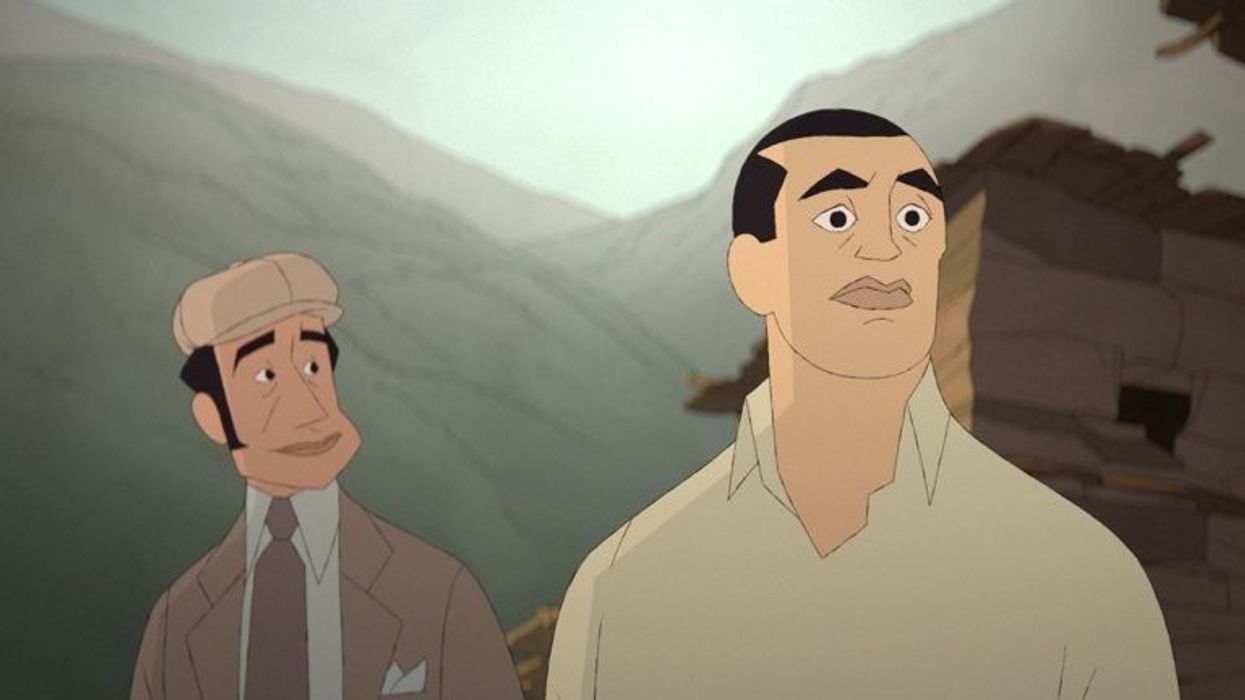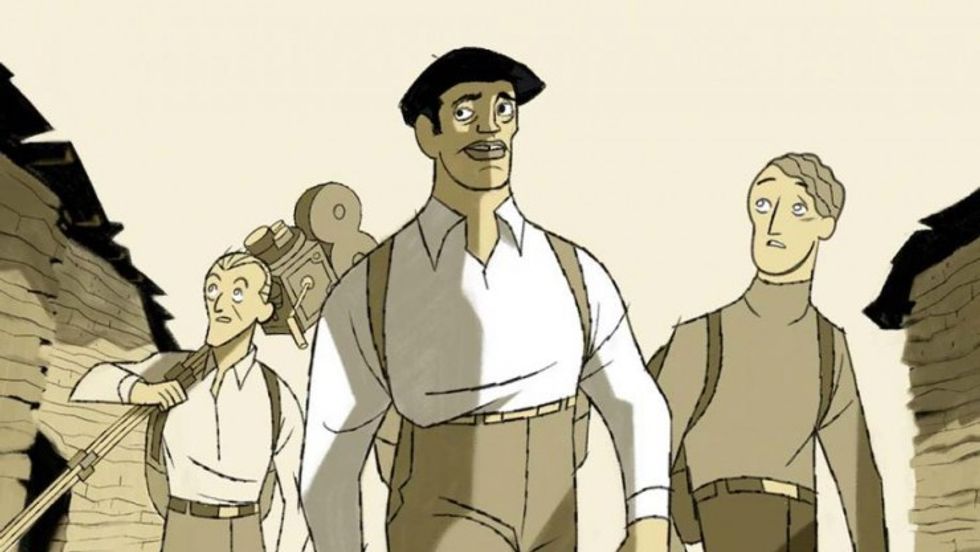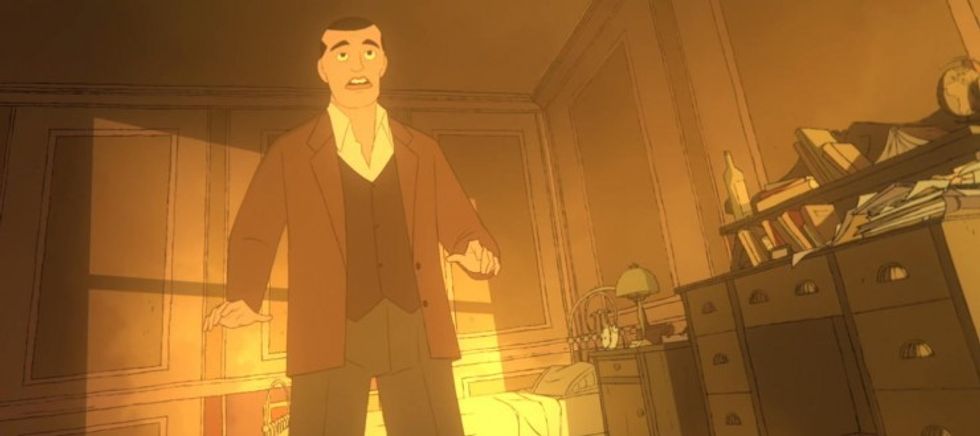'Buñuel in the Labyrinth of the Turtles' Director Reveals the Secrets of His Animated Film
For the acclaimed filmmaker, making Buñuel in the Labyrinth of the Turtles was a process of immersion and discovery.

Las Hurdes, Luis Buñuel's third film, made in 1933, is as shocking in some ways as his first two films, Un chien Andalou and L'Age d'or. Shortly after the beginning of this documentary about the lives of a dangerously impoverished population in one of the most isolated, mountainous parts of Spain, a chicken's head is ripped off. In another famous scene, a swarm of bees attacks a donkey.
These scenes are shocking, and violent, and disturbing -- and Buñuel meant for them to be that way. Inspired by a book about the people of the region lent to him by a friend, Buñuel wanted to communicate the intensity and the extreme way in which this small population lived -- and he wanted to do so in a way that would stir compassion in viewers. The film is full of images of profound poverty, rendered in an unpretentious, fascinating way. Now, Salvador Simó, after huge amounts of painstaking research, has told the story behind this film -- the story of an urbane sophisticate, one of the chief Surrealists, drawn into a project about a part of life wholly removed from his, and wholly unsurreal.
Simó's new animated film, Buñuel in the Labyrinth of the Turtles, which is in select theaters now, is an arresting and consistently involving tale. We recently had a chance to talk with the filmmaker and he revealed how the film evolved and the impact it had on him.
No Film School: What do you think Buńuel’s work and life have to teach younger filmmakers?
Salvador Simó: I’ve always been a big fan of Buñuel, and having the chance to know him, sort of, living in his story, seeing his movies, talking with many people who worked with him, and his grandson Luis, the most important thing was the honesty and truthfulness he had when he was making his films and telling his stories. He was honest in the way he talked, and the in way he saw things. In the end, you can see that with his films, what he wanted was for the audience to have questions, to think.
You might like his films or not, but they will not leave you feeling indifferent. You are going to ask yourself questions, like What is happening? What is this? Other kinds of films, you see them, and when they’re done, they’re done. That’s it. But Bunuel’s films, you take home.
NFS: Could you tell a little bit about the moviemaking aspect of the film, the extent to which it’s really about the nuts and bolts of the way the film was made?
Simó: When I began making this film, I tried not to think about it as a work of animation, specifically, but as a film. I studied film direction — the language of live action is the same. I know that people think animation is for kids, but it’s not — it’s a language, just as there’s a language we use in live action. So, by deconstructing the footage of Las Hurdes, seeing all the film that wasn't included, we had to rebuild, or reconstruct, the way the film was made. Unfortunately, there is almost no documentation of what happened in Las Hurdes. In My Last Sigh, his memoir, I think there’s about one page where he talks about Las Hurdes. Even when we talked with his grandson, who was living in Paris, he didn’t have so much information about it.
So the magic of having to imagine what clicked in Bunuel’s mind to cause him to make this change in the way he made films — that came from our life. We were working on the script for a while, and we were thinking, What happened to cause this change in the life of Buñuel? Because before, he was making these Surrealist films that were more based on images, under the influence of Dali. But after Las Hurdes, the way he made films changed. He never entirely got away from Surrealism — it came back later on — but his films became more based on the human soul and the way we behave. So I thought of my father, who is a radiologist who has been going to Africa for 30 years to install X-Ray machines in small villages and teach people how to use them. The first time he went, he went to Sierra Leone, and when I asked him what caused him to go there, he said it was the kids — the way you see their poverty. And I thought, that’s it: That’s what caused the change in Buñuel. When you look at Las Hurdes, you see that he’s interested in the kids, mainly. The schools were overpacked, the orphanages were overcrowded — the government was sending them to places that were even worse. At that time, things were really really tough in Las Hurdes. And so Luis wanted to change things. The Surrealists at that time wanted to change the world. They wanted to make everything better. But when Buñuel was going to Las Hurdes, thinking he was going to change things, he didn’t realize that Las Hurdes was changing him.
I know that people think animation is for kids, but it’s not—it’s a language, just as there’s a language we use in live action.
NFS: How did you work with the graphic novel by Fermin Solis that caused you to make the film?
Simó: The first time that the producer sent me the graphic novel, I did not agree with many things that were in it, and that was actually what made me want to make the film. I thought it was important to make people understand why Buñuel was doing what he was doing. Solis really gave us a great deal of freedom with the novel when we were making the film. We used our own artist, rather than going with the style of the book. It’s true that the graphic novel talks a little bit about what happened in Las Hurdes, but it’s done in a different way. We started from scratch, and we spent almost a year working on the script. We talked with many people — his grandson, his biographer, many Spanish artists — to make our own story. It was less a process of adaptation than a process of inspiration. The graphic novel aspired to tell this story, and then we just departed from it. Fermin was very grateful, and very nice, and he gave us total freedom.
NFS: You mentioned in an interview that the animation took a lot of preparation, a lot of building up for each frame. In what sense?
Simó: First of all, we didn’t want to move on until we had a script that was solid. I’ve been working in animation for thirty years, and I‘ve faced many situations where you’re solving problems in the script when you’re in production, and that was terrible. So, this time, I didn’t want to raise the pencil until we had a solid script. Then, I knew at that point, all the people we were bringing in — we had José Luis Ágreda, an amazing art director, we had Arturo Cardelús on the music, we had Manuel Galiana as animation direction. No one had to worry about solving problems. They only had to worry about making the film better, better, better. This movie is about teamwork. Everyone who worked on the film was passionate about it, they had it in their hearts. We did this movie with a ridiculous budget. If we had had to pay the people for the actual work that they did, we couldn’t have done it. They did it because they loved the story, and they loved Luis Buñuel. I want to think you can feel this passion in the end result.
I didn’t want to raise the pencil until we had a solid script.
NFS: How did you know when the script was solid? How many drafts would you say it went through?
Simó: I think that’s also one of the things the script teaches. When you really get to know the way he worked, you find out he was very honest with himself when he was telling the story, and he doesn’t mind if he doesn’t please everyone. You can’t make a movie that pleases everyone. They will either like it or they will not like it. And so that was the point we reached, where we decided, either people will like it or they will not like it, but this is the best way to tell the story, and the most honest way to tell the story, as far as the characters of Luis and Roman are concerned. Because there were many things that we disagreed with, that we didn’t like, but that was what was happening. And trying to soften it was not going to work. Buñuel was a complicated character, and so that’s what we had to show in the story.
NFS: Can you tell me how you arrived at the color palette?
Simó: We did what we called a color script. It’s like writing a script, except you do the same thing with the colors. We used the colors to tell the story. We assigned certain colors to certain characters. For Ramón Acín, it was the pink, and for Buñuel it was more the yellow. The audience comes to feel the way the colors interact and move through the story — they become like words. We worked for quite a few months to find out the best way to use the colors without changing too much, depending on which character we were representing. So, in some scenes, if you see a lot of pink, that doesn’t mean everything was pink, it just means it was from the point of view of Ramón. It worked well to have the cuts to the real footage of Las Hurdes — it brought the movie down to earth, giving us a space to go in another direction. So the colors of the film are constantly playing along with the black and white footage of the movie that Buñuel actually made.
Turtles is now playing in select theaters.













